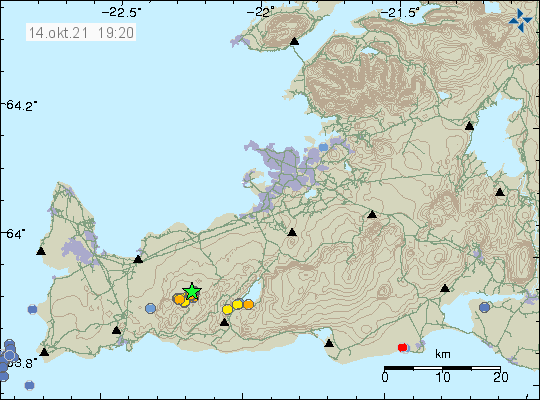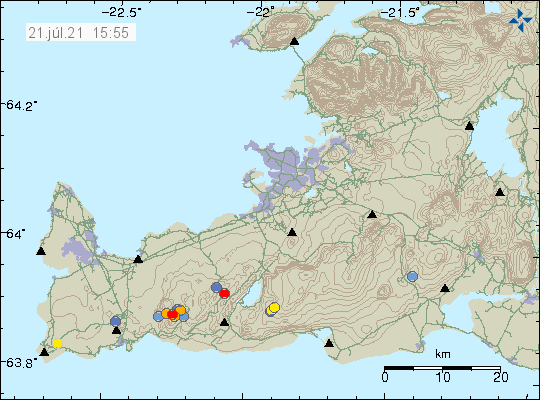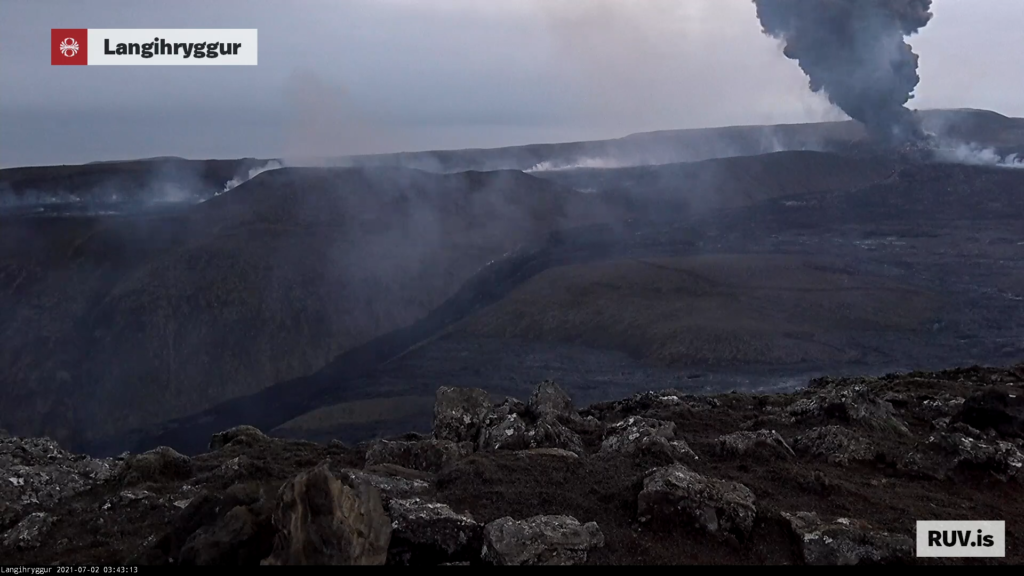Today (21. December 2022) an earthquake with magnitude of Mw3,4 took place in Krýsuvík-Trölladyngja volcano. This earthquake is because of inflation in Fagradalsfjall volcano. This possibly means that the inflation in Fagradalsfjall volcano is reaching critical point and might result in a eruption soon, when that point is reached is difficult to know.
Continue reading “Earthquake swarm in Krýsuvík-Trölladyngja volcano”
Update on 5-August-2022 on the eruption in Meradalir valley
This is a short update because not much has changed in the last 24 hours in the eruption in Meradalir valley in Fagradalsfjall mountain.
- The eruption is now in 120 meter long eruption fissure. Currently the output of the eruption is around 18 m3/sec according to yesterday’s measurements.
- The new lava has now flowed over the lava from last year (2021) and into eastern Meradalir. This is about 1 km distance that river of lava has flowed. Image of that can be found here on Facebook.
- According to chemical analyse of the magma. This is the same magma that was erupting when the eruption in the older crater stopped erupting in September. This shows that this magma is older and the new magma has not yet reached the surface.
- Fissures on the ground north-east of the eruption site have started to move and getting wider according to experts that are in the area. This strongly suggests that an eruption is about to happen soon in that location. When it starts is impossible to know. But this is going to close one way to the eruption and if eruption starts in new location south of the crater, seeing and viewing this eruption might start to get difficult or impossible, at least the part in Meradalir were the current eruption is happening now.
I think that is all for this Friday. Next update is going to be on Friday 12-August unless something major happens in this eruption and that might just happen.
Donations
Please remember to support my work with donations. Thanks for the support. 🙂
Update on 1-August-2022 on the earthquake swarm in Fagradalsfjall mountain
This is a short update on the earthquake swarm in Fagradalsfjall mountain and nearby area. This is written on 1-August-2022 at 13:47 UTC.
The situation on Reykjanes peninsula is always updating so information in this article can be in part or in whole get obsolete quickly. Largest earthquake during the night had a magnitude of Mw4,7. This might not be the largest earthquake today, since larger earthquakes are always a possibility.


GPS data have started to show a large displacement over the last 48 hours. The 24 hour GPS displacement can be found here and 8 hour GPS displacement data can be found here (find Reykjanes peninsula). This shows that magma is pushing its way though the crust at fast speed, but has not yet broken up trough the crust. When that happens is impossible to know, but this might not be a long wait based on the speed the magma is going. Current depth of the magma is around 2 to 4 km.
Earthquake activity west of Kleifarvatn lake
Yesterday (28-October-2021) two earthquakes with magnitude of Mw3,6 and Mw3,0 took place west of Kleifarvatn lake (in Krýsuvík-Trölladyngja volcano system). The first earthquake with magnitude of Mw3,6 took place at 18:36 UTC and the second earthquake with magnitude of Mw3,0 took place at 23:11 UTC. Other earthquakes that took place where smaller in magnitude.

This earthquake activity seems to be connected to magma movements in the area. It has not yet and might not result in a eruption since this is in a different fissure area. It is unlikely that this activity is connected to the magma movements that are ongoing close to Fagradalsfjall mountain.
Fewer earthquakes close to Keilir, no eruption in Fagradalsfjall mountain for almost one month
Earthquake activity continues close to Keilir mountain. But it remains at depth of 5 to 6 km and doesn’t show any sign that it is about to move to the surface. More than 10000 earthquakes have been recorded and 18 earthquakes have been recorded with magnitude above Mw3,0. This is according to Icelandic Met Office.

The eruption in Fagradalsfjall mountain (more information at Krýsuvík-Trölladyngja website at Global Volcanism Program) has not been active since 19-September-2021 and there are no signs that the eruption is about to restart soon. Global Volcanism Program no longer updates its information for this volcano as an active eruption. Icelandic scientists in eruptions have not declared the eruption over. It should be expected that the eruption in Fagradalsfjall mountain is over for now, but it can start again at the same location or at new location in few weeks time or maybe even few years from now.
Earthquake activity south of Keilir mountain
On Saturday 25-September-2021 an earthquake swarm started close to Keilir mountain, at the writing of this article this earthquake swarm is ongoing.

The eruption in Fagradalsfjall mountain has been having its longest quiet period since 19-March-2021 and at the writing of this article that is ongoing situation.
This earthquake activity suggest that the eruption time period in this part of the Reykjanes peninsula is not over, even if nothing is happening at the moment.
Krýsuvík-Trölladyngja is a volcano system is currently erupting in this area.
Article updated on 29-September-2021 at 11:49 UTC. Correct date of the earthquake swarm start added to the article.
Update on the eruption in Fagradalsfjall mountain on 19-August-2021
This is a short update on the five month eruption day in the Fagradalsfjall mountain that is part of Krýsuvík-Trölladyngja volcano system.
- The eruption continues its strange cycle of not erupting for few hours and erupting for few hours.
- The consequence of this type of eruption is that the lava doesn’t flow that far from the crater. It just piles up next to the crater making the structure ever higher. I am currently estimating (this is a guess and might be wrong) the crater at 200 meters high (-+ 50 meters).
- The eruption has now been going on for five months. Holuhraun eruption in Bárðarbunga volcano in 2014 to 2015 lasted for six months.
- At the writing of this article there are no new craters open but it doesn’t rule out that new crater might have opened but are hidden under the amount of lava that is around the main crater. As there are some extreme large caves in this lava field. Allowing for a lot of space for new crater to form and start erupting unnoticed.
There are no more updates of the eruption at the writing of this article. That might change without warning but I don’t know if that is going to happen.
Unconfirmed report about ash cloud off the coast of Krýsuvík-Trölladyngja volcano (Krísuvíkurberg)
This is possible mistaken reporting. There have been reporting of ash clouds or steam clouds off the coast during the evening of 7-August-2021. This would be in the volcano system Krýsuvík-Trölladyngja.
The ash cloud or steam cloud would indicate an activity off the coastline or possible eruption activity in the ocean. Explosive events like that appear a lot more clearly as harmonic tremor on SIL stations and according to news reports nothing has been seen so far in the harmonic tremor data. There have been no earthquake activity in the area where the clouds are supposed to have been seen.
The coast guard has been sent to this area, as they where nearby anyway. I don’t know if anything has been reported so far. The weather is fine in south Iceland and I don’t think there is a lot of ocean waves, but as this is the Atlantic ocean there can be ocean waves even if there is no wind, since the ocean waves can arrive from parts of the ocean with bad weather thousands of kilometres away.
If anything new is reported I am going to update this article or write a new one.
Deep earthquakes in Fagradalsfjall mountain
Today (21-July-2021) few deep earthquakes took place in Fagradalsfjall mountain that is part of Krýsuvík-Trölladyngja volcano system.
This earthquake activity was not big and the largest magnitude recorded was a magnitude of Mw0,8. Most depth that appeared had a depth of 13,4km.

It is difficult to know what this means. What is possibly happening is that more magma is pushing up in the magma feeding that now exist where the eruption has been happening. If that is happening, it can result in new craters or fissure opening up and start erupting. At the writing of this article this earthquake activity seems to be ongoing, but at slow rate and small earthquakes only so far.
Fog continues to block view to the crater and Fagradalsfjall mountain. But harmonic tremor data shows that the Fagradalsfjall mountain eruption is currently not erupting.
Possible end of the eruption in Fagradalsfjall mountain (2-July-2021)
At the writing of this article the eruption in Fagradalsfjall mountain has possibly ended (please note that Icelandic Met Office has not officially called the end of this eruption). This is part of Krýsuvík-Trölladyngja volcano system.
Around 03:43 UTC on 2-July-2021 the crater started erupting a cloud of volcano ash. What was unclear until earlier today was that the eruption had ended in the crater. The reason for the ash cloud was the the crater was collapsing in on it self and sealing up.

The harmonic tremor has also dropped at the same time as there is no lava flowing from the crater.

What happens next is unclear. It is unlikely that eruption is going to start in the crater that stopped erupting. Normally they almost never erupt again. Magma is going to find it self a new path to erupt once a pressure has build up again in the deep crust. Once the pressure is enough it is highly possible that new earthquake swarm is going to start before an new eruption happens on the Reykjanes peninsula. How long this is going to take is impossible to know for sure.
This is the last article about Fagradalsfjall until an earthquake or a new eruption starts in Fagradalsfjalli mountain.
